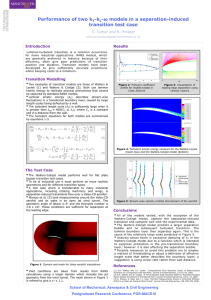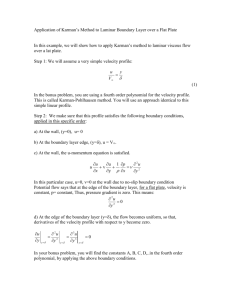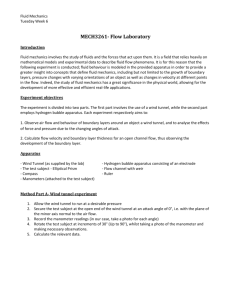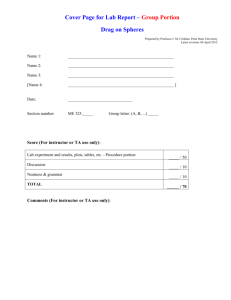MECH3261- Flow Lab
advertisement
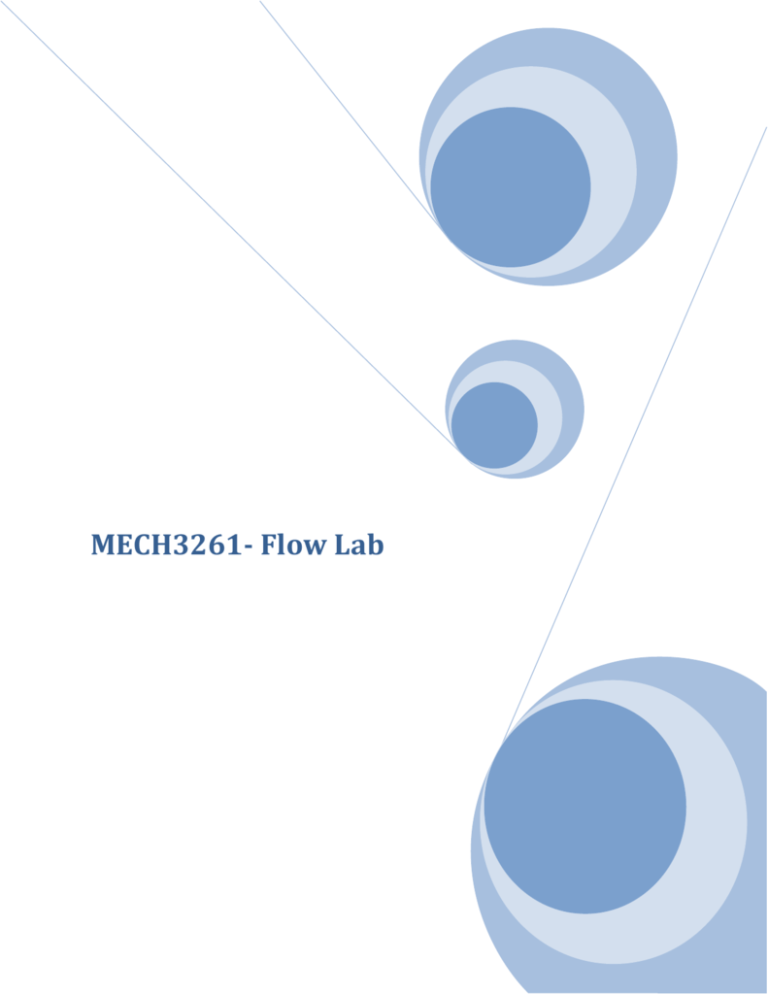
MECH3261- Flow Lab Table of contents Section Page Aim 1 Introduction 1 Apparatus 1 Methos 2 Observation & Results 3 Discussion 9 Conclusion 9 References 9 Aim The aim of these experiments is to show how flows around an object and boundary layers behave. The boundary layer experiment is designed to give a firsthand experience in observing the development of a boundary layer. The second part of the experiment is aimed at taking measurements at various points on a wing section to quantitatively study the pressure variations of the surface of a wing. Introduction Fluid flow is a very interesting phenomenon. The way fluid behaves over certain objects and how it behaves on the surface of an object need to be understood in order to have a detailed knowledge of this effect. Flow of fluids over a body is not made up of linear regions as one would expect, rather the profile of a flow depends on several factors, most importantly the surface in contact. The study of fluid flow allows us to develop more efficient designs in aerodynamics. This experiment will give us a greater insight of fluid motion. Apparatus For performing this experiment we need two main pieces of equipment. a reservoir with constant water flow over a flat plate with a weir downstream a wind tunnel with an ellipse shape containing pressure gauges Method Boundary Layer Experiment: 1. Setup the apparatus according to the diagram of the previous page. 2. An electrode is inserted into slot A and the machine is turned on that produces Hydrogen bubbles at the wire and follow the shape of the boundary layer. 3. Take the measurements of the estimated boundary layer thickness and the distance of the point from the leading edge. 4. The electrode is then moves to position B and the steps are repeated until measurements have been taken for all four locations. Wind Tunnel Experiment: 1. Observe the elliptical object inside the wind tunnel; record its size and location of the pressure taps. 2. Switch the wind tunnel on and observe the manometer readings and determine the pressure variations inside the ellipse for different angles of attack (0,30,60,90). Observations & Results Boundary Layer Experiment: Flow depths: Over the downstream weir Over the leading edge of the plate upstream y2= 3 mm y1= 3.5 mm Observed Boundary Layer thickness at points: A xa = 14 mm B xb = 15 mm C xc = 21 mm D xd = 24 mm 1. Flow Velocity: V1A1 = V2A2 => V1 = V2A2/A1 Where: V2 = √𝑔𝑦 = √(9.81) ∗ (0.003) V2 = 0.171551741 m/s V1 = 0.171551741∗8.61x10^(−4) 9.3975x10^(−4) A1 = b1y1 = (0.287-0.0185)*(0.0035) A1 = 9.3975x10-4 m2 = 0.157175896 V1 = 0.157 m/s 2. Reynolds number at points A,B,C and D: Rex = 𝐕𝐱 𝓿 Where: V = V1= 0.157 ms-1 𝓋 = 1x10-6 m2s-1 (Kinematic viscosity of water) A2 = b2y2 = (0.287)*(0.003) A2 = 8.61x10-4 m2 Rex = 𝐕𝐱 ⁄ 𝓿 9260 20,100 33,600 47,600 Point A (x =59 mm) B (x =128 mm) C (x =214 mm) D (x =303 mm) 3. Expected boundary layer thickness at points A,B,C and D if the flow was: Using Rex from part 2 and putting in the equations below: Point Equation => Laminar Turbulent A (x =59 mm) B (x =128 mm) C (x =214 mm) D (x =303 mm) 2.851015 mm 4.198217 mm 5.428716 mm 6.457912 mm 3.608389504 mm 6.704314128 mm 10.11415289 mm 13.35687417 mm 4. Comparing the theoretical results with the experimental: Point A B C D Laminar Turbulent 2.851015 mm 4.198217 mm 5.428716 mm 6.457912 mm 3.608389504 mm 6.704314128 mm 10.11415289 mm 13.35687417 mm Experimental 14 mm 15 mm 21 mm 24 mm The experimental results seem way off the theoretical results by factor of 2 in most cases. This may be due to experimental errors such as measurement which was done by a ruler in this experiment. Since the numbers in turbulent flow compared with the laminar are a lot closer to the experimental values, we can conclude that the flow was turbulent. 5. Discuss the development of the boundary layer. In “discussion” section on page 9. Wind Tunnel Experiment: Length of major axis of ellipse: 100 mm Length of minor axis of ellipse: 40 mm Station Number TAP 1 TAP 2 Pref 1 2 3 4 5 6 7 8 9 10 11 12 13 14 15 16 17 18 19 20 21 22 23 24 Manometer Reading (mm) Angle of Attack (degrees) 0 30 60 90 96.52 91.44 86.36 81.28 118.11 109.22 93.98 91.44 119.38 119.38 119.38 119.38 130.81 139.7 142.24 142.24 130.81 139.7 143.51 142.24 132.08 140.97 144.78 143.51 137.16 140.97 149.86 144.78 139.7 142.24 147.32 147.32 142.24 138.43 149.86 144.78 144.78 139.7 147.32 146.05 144.78 139.7 142.24 144.78 121.92 106.68 121.92 119.38 116.84 139.7 139.7 142.24 104.14 137.16 139.7 142.24 96.52 137.16 142.24 142.24 95.25 119.38 144.78 139.7 104.14 96.52 127 147.32 114.3 114.3 109.22 134.62 134.62 90.17 86.36 99.06 139.7 105.41 85.09 83.82 127 116.84 83.82 104.14 134.62 132.08 109.22 83.82 127 137.16 101.6 104.14 129.54 137.16 127 132.08 129.54 139.7 142.24 142.24 127 137.16 139.7 139.7 119.38 119.38 119.38 119.38 Coordinates x y 49.5 49 44 34 18 0 -18 -34 -44 -49 -49.5 -50 -49.5 -49 -44 -34 -18 0 18 34 44 49 49.5 50 2.82 3.98 9.50 14.66 18.66 20.00 18.66 14.66 9.50 3.98 2.82 0.00 -2.82 -3.98 -9.50 -14.66 -18.66 -20.00 -18.66 -14.66 -9.50 -3.98 -2.82 0.00 Wind Tunnel Dimensions: Section Tap 1 0.6 Length (m) 0.36 Area (m^2) Tap 2 0.3 0.09 1.2 kg/m3 998 kg/m3 1.80x10-5 Pa.s Density of air (p) Density of manometer fluid (pm) Dynamic Viscosity of air Projected Area In Freestream Angle (degrees) 0 30 0.012 0.015 Area (m^2) 60 0.025981 90 0.03 1. Velocity of the flow in the wind tunnel: The velocity can be found by applying Bernoulli’s equations between section 1 and 2 of the wind tunnel: 𝑃1 𝑝 + 𝑉1 2 + 𝑔𝑧1 = 𝑃2 𝑝 + 𝑉2 2 + 𝑔𝑧2 z1 = z2 𝑃1 𝑝 + 𝑉1 2 But = 𝑃2 𝑝 + 𝑉2 => 𝑉2 − 𝑉1 = 2 2(𝑃1−𝑃2) 𝑝 P1-P2 = pmg(h2-h1) & V1A1= V2A2 𝑉2 − 𝑉1 = Therefore 2(pm𝑔(ℎ2−ℎ1)) 𝑝 𝑉2 = => 𝑉2 − 2𝐴1(pm)𝑔(ℎ2−ℎ1) 𝑝(𝐴1−𝐴2) 𝑉2𝐴2 𝐴1 = 2((pm)𝑔(ℎ2−ℎ1)) => 𝑉2 = 𝑝 2∗0.36∗998∗9.81∗(0.11811−0.09652) 1.2∗(0.36−0.09) V2 = 469.7 m/s 2. Reynolds number for each angle of attack: Re = 𝐕𝐃 𝓿 Where V is the velocity, D is the projected area and 𝓋 is the dynamic viscosity of air. Angle (degrees) Re 0 30 60 5 5 3.13x10 3.91x10 6.78x105 90 7.83x105 = 469.7 3. Normal force due to pressure for each angle of attack 𝐹𝑁 = 𝑑𝑙(𝜌𝑔∆ℎ), where: l is the height of the wing section = 0.3 m d is the distance between 2 manometer points on the section of the wing ∆ℎ = Pref pressure – point pressure 𝑔 = 9.81 m/s2 𝜌 = Density of manometer fluid = 998 kg/m3 0 degrees 0.6 0.4 Normal Force 0.2 0 -0.2 1 3 5 7 9 11 13 15 17 19 21 23 17 19 21 23 -0.4 -0.6 -0.8 -1 Station Number 30 degrees 0.6 0.4 Normal Force 0.2 0 -0.2 1 3 5 7 9 11 13 15 -0.4 -0.6 -0.8 -1 Station Number 60 degrees 0.6 0.4 Normal Force 0.2 0 -0.2 1 3 5 7 9 11 13 15 17 19 21 23 17 19 21 23 -0.4 -0.6 -0.8 -1 Station Number 90 degrees 0.6 0.4 Normal Force 0.2 0 -0.2 1 3 5 7 9 11 13 15 -0.4 -0.6 -0.8 -1 Station Number 4. Total pressure drag and the corresponding drag coefficient: To find drag force only the x component of the normal force is necessary where: 𝐹𝑥 = 𝐹𝑁 × cos 𝜃 𝐶𝐷 = 𝐹𝐷 0.5𝜌𝑣 2 𝐴 𝐹𝐷 = ∑|𝐹𝑋 | We obtain the following values for Drag coefficient and Drag force: 0 Deg 2.14 0.91 30 Deg 2.43 1.03 60 Deg 5.19 2.21 90 Deg 5.49 2.33 Discussion Boundary Layer Experiment: From our results we can see that the boundary layer is a function of the downstream length and the Reynolds number. The further downstream the larger the boundary layer thickness. The only way to minimize the boundary layer thickness without changing the geometry of the experiment is to increase the velocity. Increasing the velocity increases the Reynolds number which decreases the boundary layer thickness. Wind Tunnel Experiment: It can be seen from the above results that as the angle of attack increases so does the drag force. Since the drag force is proportional to the drag coefficient then also the drag coefficient increases with a increase of angle of attack. Conclusion From the readings that have been taken and the theoretical results calculated for the hydrogen bubble experiment it can be seen that our results obtained were off experimental readings by a factor of 2 at most points This may be due to experimental errors such as measurement which was done by a ruler in this experiment. Since the numbers in turbulent flow compared with the laminar are a lot closer to the experimental values, we can conclude that the flow was turbulent. The wind tunnel has allowed observation and firsthand experience in measuring drag coefficient and calculating drag force. In general the results obtained are not accurate and this experiment is more correctly modeled as a qualitative experiment. References Experiment handout “Introduction to Fluid Mechanics” 7th Edition, by Fox and MacDonald “Fundamentals of Thermal-Fluid Sciences” 3rd Edition, by Cengel and Turner http://www.aerospaceweb.org/question/aerodynamics/q0184.shtml http://www.av8n.com/how/htm/aoa.html
